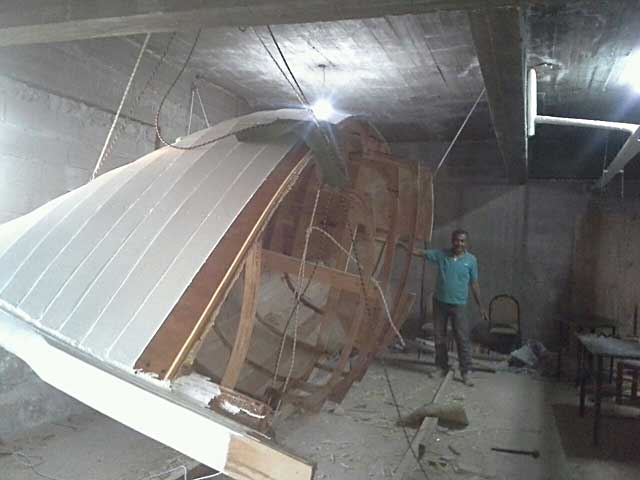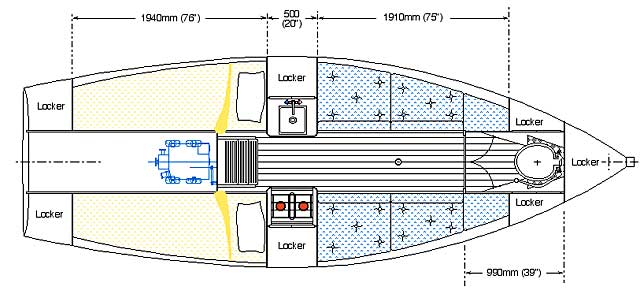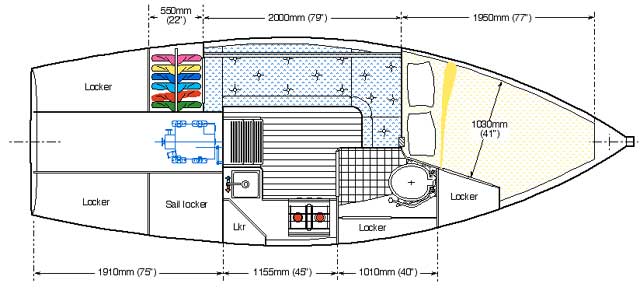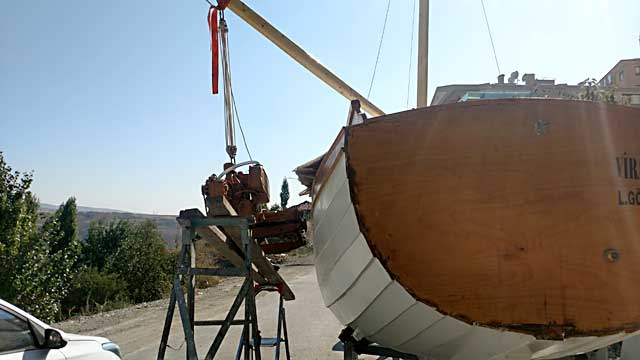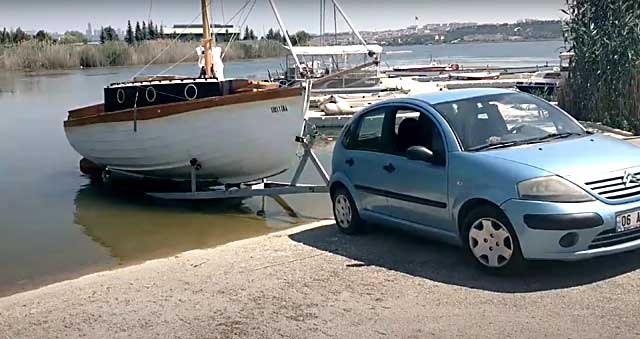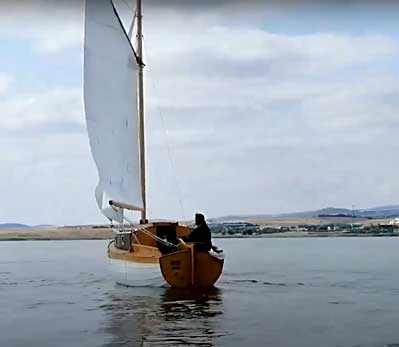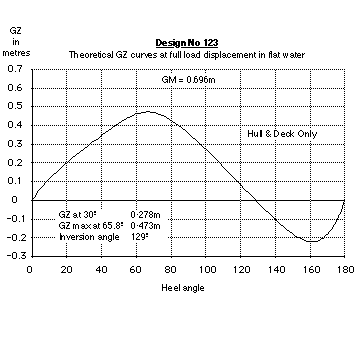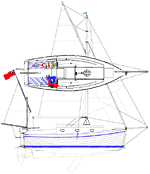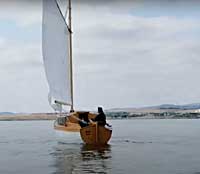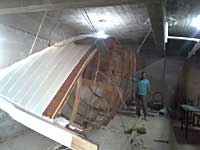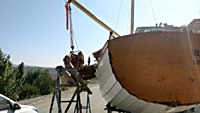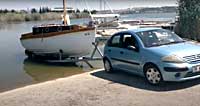| Specification | ||
|---|---|---|
| LOA exc. bowsprit | 6.090 m | 19'11¾" |
| LWL | 5.770 m | 18'11⅚" |
| Beam | 2.100 m | 6'10⅝" |
| Draft, board up | 0.600 m | 1'11⅝" |
| Draft, board down | 1.340 m | 4'4¾" |
| Displacement on dwl | 1452 kg | 3200 lbs |
| Ballast | 518 kg | 1142 lbs |
| Main area | 12.000m² | 129.17ft² |
| Mizzen area | 2.258m² | 24.31ft² |
| Staysail | 5.202m² | 55.99ft² |
| Jib | 6.129m² | 65.97ft² |
| Headroom | 1.500 m | 4'11" |
| Outboard (in well) | 4.5-7.5 kw | 6-10 hp |
| Engine | 11 max kw | 15 max hp |
| EU Category B - Offshore | ||
Design No. 123 – 6.090m (18'8¾") 3-berth or 4-berth yawl
Design 123, at 20' is the largest of our Pocket Cruisers. As with all of these boats, she is a roomy for her size, and is a robust and sea-kindly sail boat, with an excellent cruising accommodation. Though we don't have many photos, the design has been built pretty much all over – UK, Switzerland, Turkey, Italy and Australia to our knowledge, but not (as far as we know) in the USA. Full CNC cutting files are also available for this design.As with many of our designs she is built on laminated ring frames (six in this case) and a laminated backbone. I often see comments that laminating is difficult and time consuming but this is not necessarily the case. Laminated ring frames, in particular, offer an elegant, visually attractive and time-saving construction system. When you are building a boat, you have to consider the job as a whole. Just getting the hull built as fast as possible is not really very useful if you make yourself a lot of extra work in the process. With a ring-frame system, completion of the deck and superstructure, often the hardest part of the build, is made much simpler as the basic structure is there to receive the coamings, decking, cockpit structures and coachroofs.
The hull skin can be epoxy ply lapstrake as shown here or cold-moulded wood-epoxy. Both skin types give a strong, rigid and relatively lightweight, long-lasting low-maintenance structure. With the CNC cut parts, the frames can be made from three layers of CNC cut ply; builders of this boat and others report that they can assemble one or two frames a day by this method, which gets you up and ready to build the hull very quickly.
Now we are getting larger, several accommodation layouts can be considered. We offer two as part of the standard plans package, although several other variations have been built:
Four-berth. This traditional style cruising accommodation has two quarter berths aft and two settee berths in the saloon. The separate WC compartment is in the traditional spot forward, with the foot of the settee berths extending into it. The galley units, comprising a sink unit and a cooker unit, both with stowage beneath, are locaed to port and starboard, between the settee berths and the quarter berths. All in all, an excellent sea-going accommodation – the quarterberths making the very best off-watch sea berths. You can also view the four-berth accommodation in a pdf document (opens in a new window).
Three-berth. This modern style accommodation has a great full-size double berth forward and a really comfortable L-shaped settee berth to port in the saloon. The separate WC compartment to starboard is large for the size of the boat and can have a shower if required and a fold-down basin in the locker outboard. The L-shaped galley aft houses a sink and cooker, with plenty of locker space below and in the corner locker aft. There is a hanging locker aft of the settee berth. Because there are no quarter berths, the cockpit locker stowage on this layout is substantial. While a double forward is not necessarily the most comfortable sea-going berth, its extra comfort in harbour is really worthwhile. And the settee berth, fitted with a lee cloth does make a very good sea-berth, so you can have the best of both worlds. You can also view the three-berth accommodation in a pdf document (opens in a new window).
Whichever layout you choose, the furniture units are stylish and practical. Everything is properly sized and proportioned and carefully laid out to maximize the usage of the available space. On this boat, the centreboard is completely beneath the cabin sole, so there is considerably more freedom than in the smaller Pocket Cruisers.
A disadvantage of the centrecase being below the cabin sole is that it is also completely below the waterline, which means that it can't be serviced while the boat is afloat – should the centreboard become jammed with mud or stones for example. Plans are available for an offset centreboard, using a bunk front as part of the case. This brings the top of the case above the waterline and makes servicing while afloat possible. The performance of the centreboard shouldn't be affected.
The cockpit is roomy, well-protected and comfortable; and long enough for two additional full-length berths with a tent over the boom, giving extra camping accommodation if wished.
Plans for both a conventional inboard diesel engine installation, or an outboard in a well in the cockpit, are included. Either installation gives an excellent performance under power in ahead or astern, or motor-sailing. There are however some differences in the construction between the two formats, so this does need to be decided early on.
While #123 is quite a large boat, she is still trailerable without difficulty and can be launched and recovered relatively easily. Like all the Pocket Cruisers, she has an external lead ballast keel to give excellent stability and performance under a wide variety of conditions. Two rig configurations are included in the Plans Package: a yawl rig with a gaff main and a standing lug mizzen; and a cutter rig with a gaff main. Both rig plans are downloadable from the Study Plans. Either rig provides a powerful performance and ease of reducing sail area when required.
The boat could also be rigged as a sloop (a genoa in place of the jib and staysail). And an option with the staysail is to set it on a club boom (a boom shorter than the foot of the sail), which makes it self-tacking like the main and mizzen. That also means that a reduced rig of main and staysail, or mizzen and staysail, become a very convenient sail plan both in heavier weather, or when tacking in confined waters – say up an eastuary on a quiet evening with lots of moored boats.
Click here to look at the free study plans, sample instructions and specification for this design, plus a full list of the plans and instructions that come with the design package. Study plans are there to give you a feel for the construction and completion of the boat and samples of how the plans and instructions are presented.
The detailed and accurate plans together with true step-by-step building instructions carry builders, professional and non-professional alike, through the building process simply and easily. Plans are fully dimensioned; no scaling or lofting is required. The plans and instructions are practical, clear and detailed, containing everything required to build and complete the vessel. Professional technical support is available by by email or postal mail throughout the build and afterwards. More plan info …


